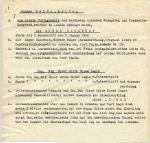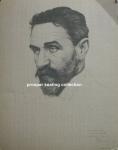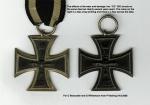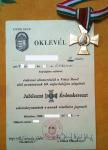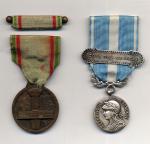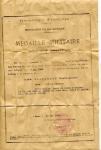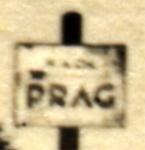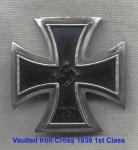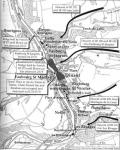-
Posts
2,284 -
Joined
-
Last visited
-
Days Won
6
Content Type
Profiles
Forums
Blogs
Gallery
Events
Store
Everything posted by PKeating
-

EK 1939 1st Type 1939 Bar to the EK2 1914.
PKeating posted a topic in Germany: All Eras: The Iron Cross
The scan doesn't do the condition of the frosting and polishing on this piece justice. As is so often the case with these early bars, two of the prongs are missing. However, never having done any research into 3rd Reich Iron Cross Bars, can anyone give me an idea of who might have made this? Godet? Juncker? TIA PK -
What a wonderful find, Chris. It is interesting to note, vis-à-vis the African-American combat regiments serving under French command because that some Senegalese battalions served with the Americans at Saint-Mihiel and in the Argonne. The SS-VT certainly murdered Franco-African POWs in May and June 1940. However, Commonwealth Blacks and African-Americans seem to have fared better on the whole. Coming back to the coupe-coupe, the psychological effect of such weapons, like the Kukri and the American Bolo Knife, was probably more effective than any actual use of these edged weapons on the battlefield. There again, when one looks at some of the Mad Max-style weapons fabricated by trench-raiders, they were hardly less savage. PK
-

EK 1914 EK Award to Hans Boehm, German Spy, WWI
PKeating replied to ph0ebus's topic in Germany: All Eras: The Iron Cross
Here is the 1965 provenance. I hope you did not mind my intrusion into your thread about Hans Boehm but given that this is a unique memento of the Irish patriot with whom Boehm tried to form The Irish Brigade, which was not much ore successful than the British Freekorps experiment almost thirty years later, I thought you might appreciate it. PK -

EK 1914 EK Award to Hans Boehm, German Spy, WWI
PKeating replied to ph0ebus's topic in Germany: All Eras: The Iron Cross
Shortly after the photographic portrait was shot, possibly by Fanto in his Dresden studio, Casement went to Munich as the website to which you linked us states: The collection had been accumulated in Germany in the 1920s and early 1930s by Rücker, a Sudeten German from Czechoslovakia who was Director of Dresden’s prestigious Europa-Hof hotel at the height of the Weimar era, when Dresden was a swinging place. Casement had apparently stayed there a couple of times during his visits to the city in 1915 and 1916 and Professor Fanto clearly thought his friend Rücker would appreciate the stone proof. A 1965 inventory of the Rücker collection by Rücker's daughter gets the date of the above image wrong, referring instead to a photo taken of Casement in Dresden at some point, which he sent to Max Zehndler, a young boy living in Landsberg, whom he had befriended. This photo, with a signed dedication dated 7.1.1916, is also reproduced in the book on Page 81. However, this is the portrait for the book as the scan shows. Casement very obviously signed the portrait, which may be the signed photo to which the inventory refers, described as being in Fanto's possession. Note the handwriting style and the little break in the surname, so similar to the style of the word in ink on the portrait. -

EK 1914 EK Award to Hans Boehm, German Spy, WWI
PKeating replied to ph0ebus's topic in Germany: All Eras: The Iron Cross
Interesting thread. Daniel, I thought you might like to see this: a stone proof of the Dresden artist Leonhard Fanto's portrait of Sir Roger Casement. The photographic portrait on which it is based was shot in Dresden in August 1915, when Casement was working with Boehm, and later used to illustrate a 1917 book Casement in Deutschland. Fanto (1874-1958), who was from Austria, was known for his woodblock work but was also a theatre designer and head of the city's artistic commission. This was done in 1915 and later presented with a signed dedication by Fanto to Alfred - also known as Gustav - Rücker, General Manager of the famous Europa-Hof hotel in the 1920s who formed a noted collection of autographed pictures of notable people in the 1920s and 1930s. The signature on the bottom is interesting as it bears similarities to Casement's handwriting style. Did Casement sign this stone proof for Fanto using the Gaelic form of his name: Easmainn, in a mood of Irish nationalism as he and Boehm tried to form The Irish Brigade? Is that his signature in Irish? It certainly doesn't look Germanic. -

VITÉZI REND JUBILEE CROSS 1989
PKeating replied to PKeating's topic in Central & Eastern European States
From Wikipedia (Yes, I know, it's unreliable but still...) This last Captain General of the Order signed the above document. On the other hand, the title Vitéz seems to be banned in the Republic of Hungary, according to Statute IV (1947), a communist decree explicitly forbidding the use of various noble titles including Vitéz, described as an hereditary title created by Horthy in 1920. Efforts since the defeat of Bolshevism in 1989 to have this Statute revoked have been unsuccessful. In 2009, the Constitutional Court stated: "... necessary to add that the Statute serves the abolition of discrimination of people on the basis of descent, which is, as the ministerial rationale of the bill conveys, "can not be compatible with the democratic public and social arrangement standing on the basis of equality. Thus, the Statute is supported by such a definite system of values that is consonant with, moreover, is an integral part of the values derived from paragraph 70/A. § (1) of the Constitution in force, prohibiting discrimination." Total pseudo-egalitarian claptrap uttered by civil servants formed during Bolshevism, sucking up to their political masters in the EUSSR halls of power in Brussels and Strasbourg and drinking from the communal cup of eternal guilt reserved for the losers of WW2. However, the Deputy Prime Minister of Hungary was made a member of the Order in 2010 and in March 2011, proposals for revoking all legislation from 1944 to 1990 have been put forward for consideration, an initiative that would of course see Statute IV abolished. Other information: http://www.icocregister.org/history.htm As we can see, some fairly heavyweight people and organisations have recognised the Order as still extant. Can it be worn in front of HM Queen Elizabeth II? Given that her husband presided over ICOC congresses, I should think so. As Hunyadi says, no mule and forty acres, but I will tell my friend that he is indeed a Hungarian knight and that his son may adopt the title as well. PK -

VITÉZI REND JUBILEE CROSS 1989
PKeating replied to PKeating's topic in Central & Eastern European States
So the Eton-educated Anglo-Hungarian British civil servant who presented this to my friend was not mistaken when he told my friend that he was a Vitéz Knight. After all, the insignia of the Order of Vitèzi Rend was not awarded at that time and the order itself was effectively dormant. So this was their way of expressing appreciation for services rendered at a certain level. -

EK 1914 The simple WW1 EK2...
PKeating replied to Chris Boonzaier's topic in Germany: All Eras: The Iron Cross
Time for an interlude. I can't remember if I actually sent this to Chris and Gordon for their website. Ah yes, I remember going to Spinks as a fourteen year old with a friend and old man Joslin pulling open a drawer of 1914 EK2 tied together like so many cheap trinkets. £1.50 each but he gave us two each for a fiver all-in, one of which was the CD 800 on the right here. Years later, my interest in militaria rekindling on an exercise in Germany, I entered a shop in Paderborn run by an angry-looking man in a loden jacket with a goatee. He looked like an Odessa official. But he became friendly when he realised that I spoke some German and wasn't asking for Nazi stuff, that I was interested in the cross you see on the right, which is in mint condition with a full-length riband and a black-stoved safety pin, as issued. He said he had it from the family and that it must have been sent after the death of the man who got it in 1915. Hearsay, of course, but no reason to doubt it. Years later, as makers became important, I compared them and found they had been been struck on the same dies, the core die having been damaged at some point, as the flaw across 1813 shows. So, looking at all of the wonderful period photographs you have posted, some of the earlier ones probably show CD 800s like the mint one and later examples like the flawed cross. PK -

VITÉZI REND JUBILEE CROSS 1989
PKeating replied to PKeating's topic in Central & Eastern European States
That is strange. I responded the other day thanking you for your reply but my post is not here. Once again, thank you very much for responding. My friend is British. He was a journalist who proposed bringing a resistance leader back to Budapest n 1989 just before the collapse of Communism for a reunion with an old comrade of the 1956 Uprising. They were stopped afterwards by some very aggressive security agents but my friend succeeded in concealing the cassette, handing over a camera with a cassette containing harmless images. He says they were detained for a while and were quite frightened. The exiled resistance man had asked him beforehand if he thought the reportage would be good for Hungary and then consulted his comrades. Of course anything that reminds of how badly the Bolsheviks behaved is by default a good thing so they did the story. It was very moving. Later on, my friend was invited to a dinner in London where he was formally awarded this citation and the insignia, issued in Munich. He was told that he could wear this insignia in front of the Queen or any crowned head of Europe as it was absolutely official but he is not the sort of fellow who wears awards. However, he was recently told by an Anglo-Hungarian colleague that not only could he wear it but could also put "V" before his name, for "Vitéz" and that so could his eldest son on reaching the age of seventeen. He is skeptical of this as the insignia is the Jubilee Cross of the Order of the Vitéz Knights, rather like the MBE as opposed to the CBE or the MVO as opposed to the CVO. I expect that even if it is not too hard to earn this award, it might earn him a few free beers in downtown Budapest, especially as they gave it to him for actually doing something a bit risky for the cause of freedom in Hungary. Like the Border Guards, who took a bit of risk opening the frontier. Mind you, I think the actual border guards who did this should have been individually honoured rather than the unit, as many Hungarian border guards were utter bastards. PK PK -
A friend of mine was awarded this certificate and cross in Germany in 1989 for services rendered. He asked that his name and details be obscured. The cross is by Deschler. I looked up the original order of 1921 but we would like to know more about this award. The recipient was told that he could, for instance, wear this in the presence of HM Queen Elizabeth II and other monarchs. So, anyone?
-
A belated thanks, Paul! Both for the general comment and for your informed opinion. It is always wonderful to come across things that were actually worn, isn't it? I will take a liberty and wander off topic a bit more with the scan below, which shows an Afrique Noire ribbon bar actually worn by the recipient. I just responded to our colleague Lorenzo in another thread and thought it might be worth posting my comments here, as they relate to the original Syrie-Cicilie Medal.
-
As Vétéran says, the price is fine. These are seen on the market all that often. Don't know if you noticed this thread about these medals but it should provide some background. CLICK HERE The medal was conceived after General Castelnau proposed a commemorative medal to the Paris Parliament following the capture of Aïntab in February 1921 during the Franco-Syrian War of 1919-1921. As a footnote, King Faisal of Syria was exiled to Britain and later installed as King of Iraq. Faisal was, of course, the Arab leader played by Anthony Quinn in Lawrence of Arabia. The Arab army against which French forces fought was the same army that had seen off the Ottoman Turks so it was a relatively hard-won victory for the French. The 30 mm medal was exclusively struck in bronze by the Paris Mint but there was a 36 mm variant produced by Arthus-Bertrand. And, of course, J R Gaunt of Birmingham, England produced the above variant for the Free French government-in-exile in London during the War but that is covered in the thread to which I've linked you. The original Syrie-Cicilie Medal, an example of which you have found, was instituted on 18.7.1922 and was initially awarded for the period from 11.11.1918 to 20.10.1921. If Vétéran says the LEVANT clasp was unofficial but tolerated, he is a man to be believed given his vast experience and knowledge of the medals of France. One learns something new every day, which is what makes forums like this great. If I can add a footnote, on the other hand, the LEVANT clasp in bronze signalled participation in operations from 1918 to 1921 whereas there was a silvered version denoting operations in 1925 and 1926. This medal was never intended as a catch-all regional service medal, however. Recipients applying for the medal from 1922 to 1939 had to have participated in one or more specific actions during the two periods in question authorised by a series of twenty-four Republican degrees. Next-of-Kin had to prove the deceased qualified. The medal was then issued by the Vichy regime as the Levant Medal, with the above clasp, while the Gaullist authority in London instituted their own version with no clasp and the words Syrie-Cicilie removed from the reverse. Civilians were eligible from 1932-onwards. So, there you go, Lorenzo.
-
It's perfectly genuine but probably struck in the 1970s or 1980s, like many WW2 French medals one sees on the market. PK
-
Gordon W reckoned it was K&Q. It would be nice to find it was by Juncker. The quality suggests a top maker. PK
-
It is by Klein & Quenzer. Anyway, I have put it up for sale. According to my calculations, the Reichmark was worth around $5.00 US in 1939, which equated to £1 Sterling. So this cross retailed for the equivalent of £3/15s or around $18.00. Joe is offering 5 RM. That's $25.00 in 1939 money, which was about the average weekly wage in the US then. £3/18s was the average weekly wage in Great Britain. Given that the average weekly wage in the US today is - allegedly - $1,200.00, that's $240.00. Of course, we must then add the collectability premium plus a further loading for scarcity. Seriously though, thanks for the answers on and off-line.
-
Not to scale. There is still much to learn about French awards and rules from the viewpoint of non-French collectors. For many years, I believed the Médaille Militaire was reserved for Generals and Senior NCOs. To digress from Chris' WW1 focus for a moment, there is a man living near me who was deported for resistance activities. He is a holder of the MM and an Officer of the Legion of Honour. I believe he also holds the Croix de Guerre. So there is an example of an MM awarded for valour to a man who was not actually a member of the regular armed forces when he was active in the FFI in Paris in 1942 and 1943. I believe the FFI was "regularised" by General de Gaulle's HQ in 1944, wasn't it?
-
-
-
The Tschoffen Wall in the Faubourg Saint-Nicholas district where "116 inhabitants of Dinant were shot by the Saxon hordes on August 23rd 1914", as the caption says. These Saxons were from Leib-Grenadier-Regiment (1. Königlich Sächsisches) Nr. 100. IR 178 was Infanterie-Regiment (13. Königlich Sächsisches) Nr. 178, IR 104 was Infanterie-Regiment Kronprinz (5. Königlich Sächsisches) Nr. 104 and IR 107 Infanterie-Regiment Prinz Johann Georg (8. Königlich Sächsisches) Nr. 107. On the other hand, the only IR 148 reference I can find is 5. Westpreußisches Infanterie-Regiment Nr. 148. So most of the perpetrators would indeed appear to have been Saxons.
-
A 1919 study by a local lawyer, Edouard Gerard, refers to two companies of IR 148, which advanced into Dinant on 7.8.1914 from Givet. The study also mentions IR 178, which was certainly a Saxon regiment, and Artillerie-Regiment 108, which is described, if I recall rightly, as starting the massacres at 21.30 hrs on 21.8.1914 after receiving an order from Corps HQ to kill all civilians and burn down their houses. Soldiers of IR 178 marched through the Leffe district killing anyone who crossed their path. Cavalry and guardsmen are also mentioned in passing. In all, more than 650 Belgian civilians were murdered in and around Dinant. Other references mention IR 104 and 107, both Saxon, which destroyed 130 of the 138 houses in Surice, some 20 km from Dinant, and killed 69 locals, as well as 23. Division, which entered Dinant on 23.8.1914. And from German Atrocities 1914 A history of Denial (Horne & Kramer 2001 - Trinity College, Dublin):
-
A 1919 study by a local lawyer, Edouard Gerard, refers to two companies of IR 148, which advanced into Dinant on 7.8.1914 from Givet. The study also mentions IR 178, which was certainly a Saxon regiment, and Artillerie-Regiment 108, which is described, if I recall rightly, as starting the massacres at 21.30 hrs on 21.8.1914 after receiving an order from Corps HQ to kill all civilians and burn down their houses. Soldiers of IR 178 marched through the Leffe district killing anyone who crossed their path. Cavalry and guardsmen are also mentioned in passing. In all, more than 650 Belgian civilians were murdered in and around Dinant. Other references mention IR 104 and 107, both Saxon, which destroyed 130 of the 138 houses in Surice, some 20 km from Dinant, and killed 69 locals, as well as 23. Division, which entered Dinant on 23.8.1914. And from German Atrocities 1914 A history of Denial (Horne & Kramer 2001):
-
It seems to be a classic Paris Mint issue with the suspender and, I would say, the clasp by the sub-contractor Mercier. The Cornucopia and ARGENT marks indicate an early pre-1900 strike. Regarding value, these early examples are rising. Five years ago, you easily could get one of these medals in this condition for €40.00 to €60.00 in France. I was going to suggest €100.00 to €120.00 for such an early example but I thought I would do some research for you beforehand. There is a later type with TONKIN and TUNISIE clasps by Chobillion, which are not these beautiful 'clapette' type clasps, on a French dealer's list for €150. And here is one like yours on French eBay with a starting price of €145.00: http://cgi.ebay.fr/MEDAILLE-COLONIALE-ARGENT-BELIERE-BIFACE-TONKIN-/200598281817#ht_500wt_1028 It attracted no bids so the starting price was evidently too high for local tastes. Here is another that realised €68.00 in March, which I would say was a bargain price: http://cgi.ebay.fr/Medaille-coloniale-1er-type-agr-TONKIN-a-clapet-/200584345474#ht_3801wt_1013 If you were putting a value on the medal you have for insurance purposes, then around €140.00. Pricing it for sale purposes is another matter. Some of the French dealers trying to inflate the values lately might occasionally succeed in persuading customers outside France to pay 50% more than a French collector would pay but let's put it this way: if you got this for under €100.00, that's OK. Hope this helps, Timo. P
-
-
They have released photographic evidence of his demise.



